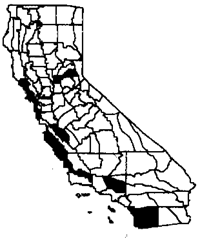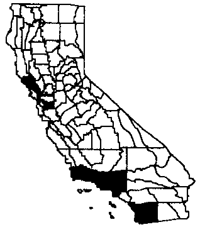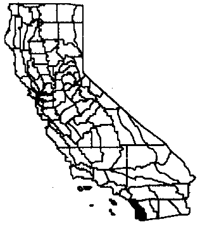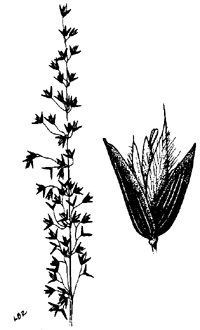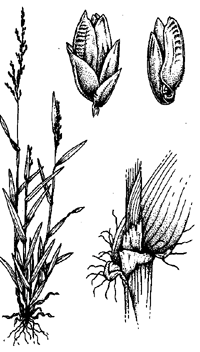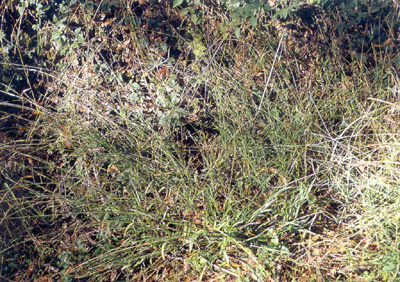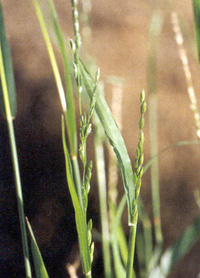|
Ehrharta spp.
|
|
|
|
Scientific name
|
Ehrharta spp.
|
|
Additional name information:
|
E. calycina Smith; E. erecta Lam; E. longiflora Brey
|
|
Common name
|
perennial veldt grass; ehrharta, panic veldt grass; annual veldt grass
|
|
Synonymous scientific names
|
none knowns
|
|
Closely related California natives
|
0
|
|
Closely related California non-natives:
|
no others
|
|
Listed
|
CalEPPC List A-2,CalEPPC List B,CalEPPC Need more information,CDFA nl
|
|
By:
|
Andrea J. Pickart
|
|
Distribution
|
| E. calycina |
|
| E. erecta |
|
| E. longiflora |
|
|
HOW DO I RECOGNIZE IT?
Distinctive features:
|
Perennial veldt grass (Ehrharta calycina) is a
tussock-forming grass with numerous stems and flat, green to reddish
purple-tinged, glaucous leaves three to eight inches long. The leaves are often
wrinkled partway along the margins. Over time this grass can become a nearly
continuous cover under shrubs, but individual tussocks can be distinguished. The
inflorescence is a loose panicle above the leaves, four to six inches long,
usually open but sometimes contracted.
Ehrharta (Ehrharta erecta) is another perennial grass,
distinct from E. calycina in having a crabgrass-like habit with
decumbent as well as ascending jointed stems. The sterile lemmas of E.
erecta are without awns.
Annual veldt grass (Ehrharta longiflora) is similar to
E. calycina in having wrinkled margin blades and purplish-tinged leaves. It is
distinguished by the fact that it is annual and more sprawling, with stems
growing out from the crown before becoming erect. The sterile lemmas of annual
veldt grass are long-awned, unlike those of both perennial species of
Ehrharta.
åÊ
|
|
Description:
|
| Ehrharta calycina (perennial veldt grass). Poaceae. Erect perennial grass forming dense tufts (infrequently rhizomatous) 12-30 in (30-75 cm). Leaves: flat, glaucous leaf blades 3-8 in (7-20 cm) long, 0.08-0.3 in (2-7 mm) wide, often tinged reddish purple and wrinkled partway along the margin. Ligule a prominent membrane with several awn-like teeth at the apex. Inflorescence: 4-6 in (10-15 cm) long, contracted to open panicle. Bisexual compressed spikelets subsessile to stalked, 0.2-0.3 in (5-8 mm), falling as one unit. Glumes 0.2-0.3 in (5-7 mm), becoming purplish, about equal, longer than sterile florets. Three florets per spikelet, lower two sterile and without palea; upper floret fertile with palea. Sterile lemmas membranous (becoming hard), short-awned or pointed, and soft-hairy. Fertile lemma awnless with hairy veins (Smith 1993). |
|
| Ehrharta erecta (ehrharta). Poaceae. Perennial grass. Stems: culms erect or ascending from decumbent base, branching, 12-24 in (30-60 cm) tall. Leaves: flat leaf blades 2-5 in (5-12 cm) long, 0.2-0.4 in (4-9 mm) wide. Inflorescence: 2-6 in (6-15 cm) long, contracted to open panicle. Laterally compressed sessile to subsessile spikelets, 0.1 in (3-3.5 mm), falling as one unit. Glumes 0.06-0.1 in (1.5-3 mm), about equal, longer than sterile florets. Three florets per spikelet, lower two sterile and without palea; upper floret fertile with palea. Sterile lemmas awnless, glabrous (Hickman 1993). |
|
Ehrharta
longiflora (annual veldt grass). Poaceae. Annual grass. Stems: erect. Leaves: flat leaf blades up to 8 in (20 cm) long, 0.4 in (10 mm) wide, wrinkled partway along the margin, collar sides purple. Ligule membranous and toothed. Inflorescence: spreading to contracted panicle, often fascicled. Compressed spikelets sessile to stalked, with branches and pedicels pubescent, sometimes purple, 0.3-0.4 in (8-10 mm). Glumes becoming purplish before fruit matures, the first 0.10-0.12 in (2.5-3.0 mm) and five-nerved, the second 0.16-0.18 in (4.0-4.5 mm) and seven-nerved, axis breaking above the glumes. Three florets, lower two sterile without palea, upper floret fertile with palea. Sterile lemmas membranous (becoming hard and white), seven-nerved, long-awned (about 0.3 in or 8 mm), and hairy at base of callus and base of keel. Fertile lemma seven-nerved, awnless (Brey 1996).
åÊ
|
|
WHERE WOULD I FIND IT?
|
Ehrharta calycina (perennial veldt grass) is grass is
characteristic of sandy soils and is known to occur in Santa Barbara and San
Luis Obispo counties on the south central coast and in Sonoma County. It is
prevalent in all of the upland habitats of the San Antonio Terrace (at
Vandenberg Air Force Base) and throughout the Los Osos dunes southeast of Morro
Bay. In recent years it has been increasing rapidly in dune scrub at the
Guadalupe-Nipomo Dunes (Chesnut 1999) and on the maritime chaparral and coast
live oak woodlands of the Nipomo Mesa.
Perennial veldt grass has also been reported from the Gaviota
coastal grassland terrace, where it recently spread from a few roadside
locations into a large disturbed area near the old Vista Del Mar school,
threatening high-quality native grasslands and coastal sage scrub.
Although present at Bodega Bay (Hickman 1993), the species has
increased significantly in extent in recent years. It is also widespread as a
naturalized weed in Australia (Tothill 1962, Cade 1980). It appears to be in an
explosive stage of invasion in California, and may already be present in other
areas or may appear in the near future.
At Vandenberg Air Force Base, E. calycina was found to be more
prevalent on hillsides than in the more densely vegetated swales (it is unknown
whether this was a result of fewer openings in the swales or of some
physiological tolerance of the grass). The species occurs on well drained soils
and does not tolerate inundation (Tothill 1962, U.S. Air Force 1996). Tothill
(1962) concludes that E. calycina will not survive in completely dry
soil, but since its roots penetrate deeply, it is able to exploit dry, sandy
soils. On heavy clay soils, it can be maintained only through removal of
associated species, which compete aggressively with the delicate root system of
E. calycina (Tothill 1962).
Ehrharta erecta (ehrharta) became established in
northern California about 1930 (Stebbins 1985). It has been reported from the
greater San Francisco Bay Area (Sigg 1996) and from La Jolla Shores in San Diego
County (Brey 1996). Populations have been reported from the San Francisco Bay
Area, as well as San Diego, Santa Barbara, Los Angeles, and Ventura counties
(Smith 1993, Sigg 1996, Brey 1996). E. erecta is thought to be more
invasive in the northern portion of its range, but more information is needed to
verify this. In its native range it is widespread in winter-rainfall and
tropical regions but does not extend into arid regions (Gibbs-Russell and
Robinson 1983). Sigg (1996) observed it in a wide variety of habitats in both
exposed and shady areas in the San Francisco Bay Area, including sand, heavy
soils, and thin, rocky soils. Sigg reports that the species is still vigorously
expanding its range, and that the degree of threat it poses may not yet be
apparent.
Ehrharta longiflora (annual veldt grass) is an invasive
annual that was recently discovered in the San Diego area (Brey 1996). It has
also been introduced to Australia (Cade 1980). In southern Africa it has a wider
distribution than most other species of Ehrharta, which may be an
indicator of its potential for invasiveness on this continent.
åÊ
|
|
WHERE DID IT COME FROM AND HOW IS IT SPREAD?
|
All three species of Ehrharta
present in California are native to southern Africa. E. calycina was
first reported in California in 1929, imported as seed from Australia (Love
1948). E. erecta became established as an adventive near Berkeley
around 1930 (Stebbins 1985). The former Soil Conservation Service (now Natural
Resources Conservation Service) promoted E. calycina for forage
improvement and erosion control during the 1950s and 1960s (Mulroy et al. 1992,
U.S. Air Force 1996), and it was planted on ranches and sowed on controlled
burns in coastal San Luis Obispo and Santa Barbara counties. The U.S. Air Force
stabilized sand dunes with E. calycina at Vandenberg Air Force Base in
the late 1950s (U.S. Air Force 1996), where it has since spread invasively.
The three species of Ehrharta spread primarily by
wind-borne seed. Invasions of E. calycina spread primarily in the direction of
prevailing wind (Tothill 1962) and are enhanced by disturbance (Chipping, pers.
comm.). E. erecta can also spread vegetatively (Sigg 1996).
åÊ
|
|
WHAT PROBLEMS DOES IT CAUSE?
|
The invasion of Ehrharta calycina into native shrub
communities causes a rapid shift toward grassland. The more open the original
vegetation, the more rapidly invasion occurs (U.S. Air Force 1996). The species
spreads readily into disturbed areas, such as roadsides, and from there into
openings between shrubs. Once established, E. calycina inhibits or
prevents germination and establishment of native dune scrub and chaparral
species (U.S. Air Force 1996). Studies at Vandenberg Air Force Base have
documented the dramatic and explosive increase in E. calycina cover
between 1979 and 1996. The spread of this grass is now considered to be the most
serious threat to sand dunes of the central coast of California (Chipping, pers.
comm.).
Grass invasions have been shown to alter fire cycles, causing
more frequent fires that favor the recovery of grasses over shrubs (DÛªAntonio
and Vitousek 1992). In Australia, where Ehrharta calycina is also
invasive, fire enhances invasiveness by reducing regrowth or establishment of
native species and drastically increasing cover of E. calycina (Milberg
and Lamont 1995). E. calycina creates a dense thatch during summer
months, as the plant dries and the stems and leaves lean over. In addition to
providing excellent fuel, this thatch may interfere with the germination and
establishment of native plants during the wet fall and winter.
Because wildlife abundance and diversity are related to plant
diversity, it is expected that the conversion of dune scrub to grassland will
have negative impacts on wildlife. A small-scale study carried out by the U.S.
Air Force (1996) at Vandenberg Air Force Base supports this premise.
There is no quantitative information available on the impacts of
Ehrharta erecta and. E. longiflora. However, both have been
observed to spread rapidly in wildland areas. Sigg (1996) reports that E.
erecta is able to penetrate adjacent vegetation with decumbent stems and by
going over it with ascending stems, as well as by spreading vegetatively. The
dense turf that develops makes it difficult for seeds of other species to
germinate. Noting the extremely rapid spread of E. longiflora in San
Diego County, Brey (1996) calls its invasion a ÛÏred alert.Û
åÊ
|
|
HOW DOES IT GROW AND REPRODUCE?
|
Ehrharta calycina (perennial veldt grass) spreads almost entirely by seed, although
rhizomes are occasionally present. The species has been shown to accumulate
persistent seedbanks (Pierce and Cowling 1991). E. erecta (ehrharta)
reproduces both sexually and vegetatively by means of tillers (Sigg 1996). As an
annual, E. longiflora
(annual veldt grass) reproduces only by
seed.
Ehrharta
calycina
Ehrharta seeds germinate following winter rains.
E. calycina
, a perennial, grows and flowers throughout the rainy season
(December to April) into early summer, when fog drip may prolong its
growing season (U.S. Air Force 1996). Seeds are
produced as early as January in wet years, although most fruits
mature between March and June.
Ripe seeds are shed progressively as the panicle matures, and
flowering may occur for up to twenty-five weeks (Tothill 1962). Plants
become dormant in summer in response to temperature, not lack of moisture (Tothill
1962). During summer months, when plants dry out, stems and leaves lean over,
forming a dense thatch.åÊ |
(click on photos to view
larger image)
Ehrharta
sp.
|
The drop in soil
temperatures in September and October releases dormancy, allowing plants to draw
on deep soil moisture (Tothill 1962). Root growth is rapid and extensive after
rains. E. calycina grows in dense tufts, which can survive some burial
by sand. As sand accumulates over the base of the plant, buried shoots sometimes
form lateral bunches, giving the appearance of rhizomes. True rhizomes occur
rarely. E. erecta
can create a continuous turf in moist
areas, with plants spreading both vegetatively and by seed.
åÊ
|
|
HOW CAN I GET RID OF IT?
|
Nearly all documented attempts to control Ehrharta species have
been limited to E. calycina, and the following discussion centers on
this species. It is likely, however, that techniques used on E.
calycina would be effective on the other two species, and Brey (1996)
reports good success with glyphosate used on E. erecta. As an annual,
E. longiflora control efforts would need to be appropriately timed to
its reproductive and growth periods.
Ehrharta control efforts are still new, and more information is
needed. Large-scale experiments with herbicide have only recently been
initiated. Research to identify potentially competitive native species should
also be undertaken. Regardless of the method used, more than one year of
treatment will be necessary, due to its extensive seedbank, the persistence of
which is unknown. Unless a biological control method is found, treated areas are
likely to require perpetual management to prevent reestablishment.
The invasion of E. calycina is an established
phenomenon along the central coast, and where the species has become common or
dominant it is unlikely to be totally eradicated. Regular monitoring and
treatment will be needed to detect and control regrowth or new infestations.
Prevention is the preferred strategy, and if E. calycina is detected as a new
invader low in abundance, the highest priority should be given to its
control.
åÊ
|
|
Physical control:
|
Manual methods: manual removal of
Ehrharta calycina (perennial veldt grass) has been undertaken at Los
Osos Dunes with mixed success (Chipping, pers. comm.). Care must be taken to
remove the buried base of the plant, or resprouting will occur. Removal by hand
is labor-intensive and probably stimulates germination from the seedbank.
Extremely high densities of emerging seedlings have been observed following
manual removal (Cicero, pers. comm.). Manual removal must be repeated as plants
emerge from the seedbank. In Morro Bay, areas treated two years in a row
continued to support E. calycina, although densities declined.
Prescribed burning: Although fire is sometimes used as a control
method for grasses, it is inappropriate for Ehrharta species, as
studies have shown that fire increases the invasiveness of this species (Milberg
and Lomont 1995).
åÊ
|
|
Biological control:
|
Insects and fungi: No biological control efforts have been
attempted for Ehrharta species in California. Doidge (1948) reported on
results with the fungal pathogen Uredo ehrhartae-calycinae on E.
calycina in South Africa.
Grazing: Sources have documented that Ehrharta calycina
is not a suitable forage species because it is easily stressed by grazing,
especially during flowering. Rossiter (1947) reports that E. calycina
was unable to withstand continuous or even rotational grazing at normal stocking
rates with sheep. A South African research project (Van der Westhuizen and
Joubert 1983), which involved mowing of E. calycina during anthesis,
demonstrated that cut plants recovered to a large extent, but were lower in
total available carbohydrates (46 percent of control plants). The researchers,
who were not attempting to control E. calycina, cautioned against
severe defoliation during anthesis in the year of establishment. These
observations point to the possibility of using sheep grazing as a potential
method of control.
A ten-acre (4 ha) rotational grazing experiment was initiated in
1999 at the Guadalupe-Nipomo Dunes (Chesnut 1999); the results are
pending.
åÊ
|
|
Chemical control:
|
Glyphosate (as Roundupå¨) applied as a foliar spray at 2 percent
concentration with added surfactant was shown to be effective against
Ehrharta calycina under a wide variety of conditions at the Vandenberg
Air Force Base dunes (Mulroy et al. 1992, U.S. Air Force 1996). Plants of
different ages, with and without supplemental watering and/or mowing, were
killed after one application. Spraying typically is carried out when the grass
is actively growing and green. The use of glyphosate is believed by some to be
most appropriate when E. calycina is growing as a near-monospecific
stand, since it will cause damage to associated native plants. However, some
managers have found that careful treatment of E. calycina bunches with
a backpack sprayer can reduce or eliminate impacts to other native species.
Under these circumstances it may be necessary to return and treat bunches of E.
calycina that did not receive sufficient coverage with the first application.
The grass-specific herbicides sethoxydim and fluazifop-p (Fusiladeå¨) have
also been tested for use on Ehrharta calycina at Vandenberg Air Force
Base, but results were inconclusive (U.S. Air Force 1996). Currently, efforts
are underway to test fluazifop-p at Morro Bay dunes using a concentration of
0.75 oz herbicide and 0.5 oz surfactant to 1 gallon of water (Chipping, pers.
comm.).
A study conducted by the U.S. Air Force (1996) indicates that
the use of glyphosate (as Roundupå¨) in conjunction with seeding of native
species shows potential for restoration of native dune scrub invaded by
Ehrharta calycina. The study was undertaken in an area that had only
recently become dominated by the species. First application was in December,
with five follow-up treatments over the next two years. Seeds of eleven native
dune scrub species were sown a week after the initial spraying. Most of the
established E. calycina plants were killed in the initial application.
Damage to adjacent native plants was minimal. Native cover showed a slight but
significant increase, and open cover (also a constituent of the native
vegetation type) increased substantially. Use of transplants or nursery
propagated plants might enhance restoration success.
The Land Conservancy of San Luis Obispo (1999) recently carried
out a demonstration project in which they combined the use of mowing,
glyphosate, woodchip mulch, outplanting of native container stock, and
irrigation. Long-term results will be forthcoming.
åÊ
|

